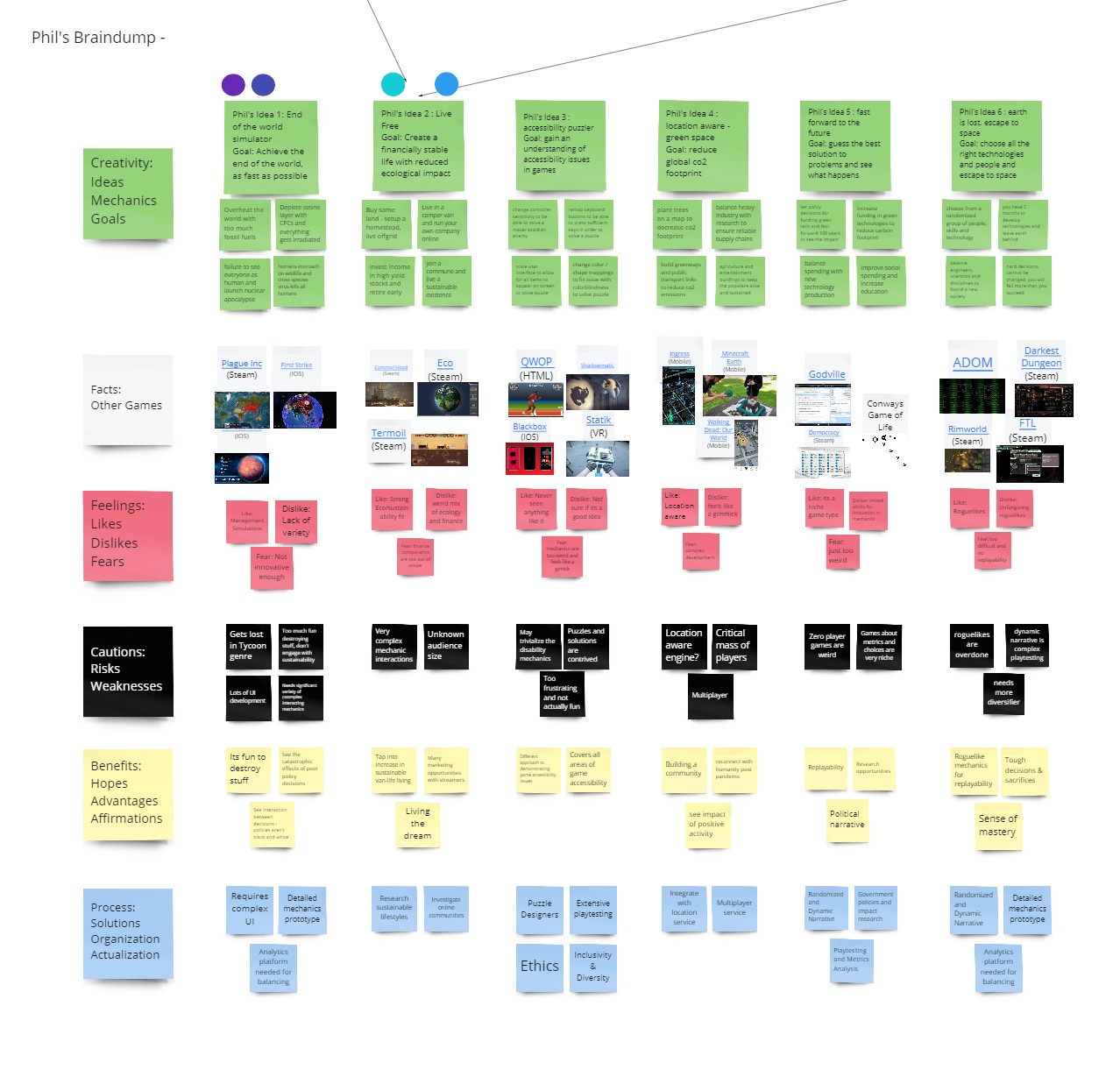Week 2 is the start of the team’s rapid ideation. The group is now formed and needs to work on ideation and setup tools for success.
Activity
As rapid ideation kicks off, it’s crucial to have a set of tools or guidelines (M. Borg et al. 2020) to ensure we don’t spend too much time worrying about how we do things and focus on the outcomes. So I set up a GitHub environment and bootstrapped a GameMaker installation, as this is our likely choice engine choice at this point. As some group members were not familiar with version control, I wrote a brief tutorial. I also recommended some changes to the default naming convention (‘Regarding Git and Branch Naming’ 2020) and suggested we adopted a slightly simplified git-flow (Atlassian 2021) branching approach.
Reviewing ideation techniques for remote teams (‘The Complete List of Ideation Techniques for Remote Teams’ 2020), we decided on six thinking hats for rapid ideation. I decided to practice six thinking hats powered by crazy eights and some opposite thinking to develop my ideas to present to the team. Two out of six of my ideas were selected by the team to go into the final stage.

While considering the game mechanics for my ideas, I was joining the ideas of synchronous and asynchronous communication challenges being faced by the group and spent some time exploring the different kinds of mechanics relating to co-operative play in synchronous and asynchronous games (Kelly 2011), (Saarenpää et al. 2009). After some discussion with the team leader, we decided that any multiplayer component would be a step too far for our time constraints, so we opted to go for a single-player experience.
Another topic of discussion was ludo-narrative dissonance, specifically within Bioshock (Hocking 2007) and experienced within Death Stranding. When game choices are not in sync with the game story, you disconnect the narrative from the player actions. Again, this is something to be mindful of while developing our narrative.
As we are a remote and disconnected team across three different time zones, I felt it necessary to set up a simple and easy place to understand what times are available for each person.
Examine and Analyse
M. Borg et al. highlight the importance of defining tools as they have high value under incredible time pressure. The Miro board has been used for initial rapid ideation, idea selection and further development of the selected idea. However, the google drive, GitHub and Trello board have not been used much by the team beyond the author.
While I enjoyed brainstorming six different ideas and reviewing ideas from each team member, I think this was too much ideation. We ended up consuming more time and generating too many ideas, which still keep being brought up by some team members and form a distraction, despite us, as a team, having chosen one. The abundance of ideas has also led to challenges with selecting key design pillars for the selected game idea (Cobham et al. 2017).
Learnings and Actions
Tool adoption is lagging, leading to isolated conversations and lack of engagement due to communicating directly, not through our shared tools. I plan to schedule workshops during our reading week to help team members understand how to use tools and their benefits to remote workers.
We still have several ideas floating around from the extended ideation techniques, despite focusing in on one. We also have a detailed day one tutorial plan. I propose that we break down the tutorial into small stories and schedule sprints to achieve the MVP. This process will also include game assets, sound, and testing to ensure deadlines are met.
References
-
BOGOST, Ian. 2004. ‘Asynchronous Multiplay: Futures for Casual Multiplayer Experience’. Other players 6(8).
-
HOCKING, Clint. 2007. ‘Ludonarrative Dissonance in Bioshock’. Click Nothing [online]. Available at: https://www.clicknothing.com/click_nothing/2007/10/ludonarrative-d.html [accessed 6 Jun 2021].
-
ATLASSIAN. 2021. ‘Gitflow Workflow - Atlassian Git Tutorial’. Atlassian [online]. Available at: https://www.atlassian.com/git/tutorials/comparing-workflows/gitflow-workflow [accessed 4 Jul 2021].
-
COBHAM, David et al. 2017. ‘From Hackathon to Student Enterprise: An Evaluation of Creating Successful and Sustainable Student Entrepreneurial Activity Initiated by a University Hackathon’. 9th annual International Conference on Education and New Learning Technologies, Barcelona, 8 July 2017. Available at: http://eprints.lincoln.ac.uk/id/eprint/25872/ [accessed 4 Jul 2021].
-
KELLY, Tadhg. 2011. ‘Opinion: Synchronous or Asynchronous Gameplay’. [online]. Available at: https://www.gamasutra.com/view/news/126424/Opinion_Synchronous_or_Asynchronous_Gameplay.php [accessed 6 Jun 2021].
-
M. BORG et al. 2020. ‘Video Game Development in a Rush: A Survey of the Global Game Jam Participants’. IEEE Transactions on Games 12(3), 246–59.
-
‘Regarding Git and Branch Naming’. 2020. Software Freedom Conservancy [online]. Available at: https://sfconservancy.org/news/2020/jun/23/gitbranchname/ [accessed 4 Jul 2021].
-
SAARENPÄÄ, Hannamari, Hannu KORHONEN and Janne PAAVILAINEN. 2009. ‘Asynchronous Gameplay in Pervasive Multiplayer Mobile Games’. In CHI ’09 Extended Abstracts on Human Factors in Computing Systems. 4213–8. Available at: https://doi.org/10.1145/1520340.1520642.
-
‘The Complete List of Ideation Techniques for Remote Teams’. 2020. Creately Blog [online]. Available at: https://creately.com/blog/diagrams/ideation-techniques-with-templates/ [accessed 5 Jun 2021].
-
WIRED. 2011. ‘US Navy Creates MMO Wargame to Fight Somali Pirates’. Ars Technica [online]. Available at: https://arstechnica.com/gaming/news/2011/05/us-navy-creates-mmo-wargame-to-fight-somali-pirates.ars [accessed 6 Jun 2021].